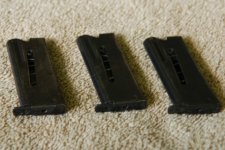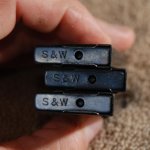
In the early 1960s, Smith & Wesson perceived the need for a small-caliber semiautomatic pocket pistol that could be used for personal protection. In January of 1963, they began working on a diminutive pistol chambered for the .25 automatic cartridge. Further development proved that the pistol could be chambered in .22 long rifle with about equal results ballistically, and that would provide for more economical ammunition. What finally resulted was the only small caliber pocket pistol S&W ever produced, and it’s become a classic and sought-after collector’s item today.
By the summer of 1965, an interesting design had been firmed up, ready for testing. S&W engineers had evidently studied the 1908 Pieper Bayard pocket pistol for inspiration. The Bayard was based on a design by Bernard Clarus of Belgium. He had patented his work in England in 1907. The similarities of the S&W pistol to the old Bayard are quite striking. The recoil spring was situated on top of the fixed barrel. Pushing back on the recoil spring guide and lifting the front sight out of the slide allowed removal of the recoil spring and guide. Then the slide and breech assembly could be slipped off, giving access to the chamber end of the barrel for cleaning. There was a manual safety lever on the left side of the pistol behind the trigger. This could be placed in the safe position whether the pistol was cocked or uncocked and while chambering a round. No hold-open device was provided. An internal hammer was utilized, and a cocked hammer indicator protruded through a small hole in the left stock. The single-action pistol was to be carried with an empty chamber for safety, although it could be employed with a loaded chamber and the safety lever in the “safe” position. The magazine held five rounds, making it a six-shot pistol with one in the chamber. The frame was aluminum, while the barrel, magazine, trigger/sear components and the slide/breech assembly were steel. The stocks were high impact plastic. The barrel measured 2 1/8 inches, and the pistol weighed all of 14 ounces including the unloaded magazine. It was easily a gun that could be hidden in the palm of one’s hand, but this concealability came at a price – with the short grip, it was a bit awkward to hold and fire.
Following extensive testing, the pistol was announced in late 1968, but production was delayed until 1969. It was sold as the .22 Escort Model No. 61 starting in March, 1970. The name “Escort” was rumored to be chosen because the pistol was ostensibly intended for discreet carry by females. However, the little gun found some favor as a hideout pistol by both sexes, often by police officers. The Model 61 could be purchased either blued or nickeled. A navy blue leatherette pistol rug marked “Smith & Wesson” was provided with the pistol. A special serial number range was assigned, and these numbers began with B1001. Almost as soon as the first pistols hit the dealers’ shelves, a change was decided upon to provide the Escort with a magazine safety, preventing discharge when the magazine was removed. This version was called the Model 61-1, and that engineering change was implemented in May of 1970, starting at serial number B7801. A special group of presentation pistols was produced in 1970, carrying serial numbers from B1 to B500. These are rarely found today. They are not from the first production run in spite of their lower serial numbers.
Another engineering change came about in September 1970 at serial number B9851. A removable barrel bushing nut was used at the muzzle, and this resulted in the Model 61-2. The pistol illustrated is one of these, and left the factory in January of 1971. I have fired this little number on several occasions, and contrary to the genre’s reputation (and my trepidations) it never failed to go “bang” when the trigger was pulled. Proper ammunition is apparently critical. To quote from S&W’s instruction sheet: “Due to inconsistent velocities and lubricants of .22 caliber ammunition it is a good policy to test fire various brands to determine which brands work best in your pistol and use this type for best performance.” The final engineering change came about in July 1971, when a forged aluminum frame was used, replacing the previous die-cast aluminum part. Minor changes to the disconnector and the breech face were also implemented. These modifications occurred at serial number B40001, and the revised pistol, the last version of the line, was known as the Model 61-3.
The Model 61 was produced until March 1973 when it was no longer cataloged by Smith & Wesson. Still, small quantities were made until February 1974 when the final supply of parts ran out. The last serial number was B65438. Although the serial numbers would indicate a total production number of 64,938, some of today’s collectors estimate a far lower number. Why was the little pistol discontinued? Controversy surrounds this decision. The gun’s unreliability with incompatible ammo has been postulated. The unusual appearance and awkward feel of the gun were probable factors contributing to unpopularity. Perhaps Smith & Wesson no longer wanted to be associated with such a concealable firearm. The official reason given was that S&W didn’t feel it was in keeping with its image as the producer of what many consider to be the highest quality handguns made.
Regardless, the engineering effort that went into the Model 61 was not wasted at Smith & Wesson. In 1987, the principles embodied in the Model 61 were implemented in a new single-action field and target pistol, the Model 422. The pistol’s lineage was quite evident, as it sported a recoil spring over the barrel and a takedown procedure identical to that used on the Escort. Even the shape of the trigger made it a dead ringer for the one used on the tiny Model 61. This pistol was manufactured until 1996. The stainless Models 622 and 622VR (ventilated rib) were produced on the same design from 1989 to 1996. The Model 2206, with all-stainless steel construction, was introduced in 1990 and was made until 1996. The Model 2213 Sportsman Stainless with a short 3” barrel came on line in 1991 and was made until 1999. Its blued counterpart, the Model 2214 Sportsman, was manufactured from 1990 to 1999. Both of these latter pistols sported the obvious features of the original Escort. So Smith & Wesson got a lot of mileage from the little gun, even long after it was discontinued.
Smith & Wesson has had but a couple of dead-end semiautomatic pistols over its long history, including the .35 Automatic of 1913, and the Model 61 Escort of 1970. Neither one achieved lasting success, with both failing to carve out a niche in S&W’s lineup of firearms. Nonetheless, each pistol has become a prized collector item today and they are eagerly sought after at gun shows and auctions if only for their unique features and limited production numbers.
The Model 61, in spite of its small grip, can be fired with some accuracy within the usual “combat” distance of seven yards. With proper ammunition, the one I shot proved to be quite reliable. It could still serve today as a hideout or backup weapon and a real deterrent to aggression when displayed. I am sure not even the most determined thug would want to be shot in the face with one. I think the little Escort pistol was an interesting exercise in engineering for Smith & Wesson, and they unknowingly created a collector item in the brief span of three years. Today, these pistols are hard to find, and their prices have escalated to reflect the demand. Was it a successful pistol? Absolutely not. Is it a classic today? Absolutely.
John
(c) 2012 JLM
Last edited:








